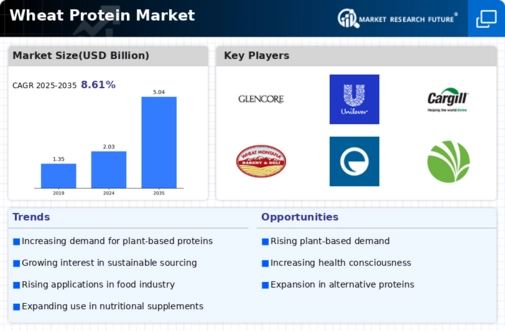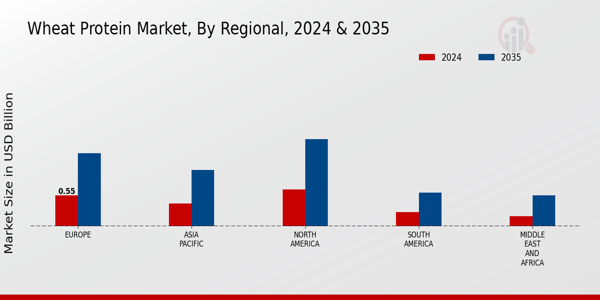Expansion of Food Applications
The Wheat Protein Market is witnessing an expansion in its applications across various food sectors, including bakery, snacks, and meat alternatives. This diversification is largely attributed to the versatility of wheat protein, which can enhance texture, moisture retention, and nutritional value in food products. Recent market analyses indicate that the bakery segment alone accounts for a significant share of the wheat protein market, driven by the increasing demand for healthier bread and pastry options. Additionally, the rise of meat substitutes has led to innovative formulations that incorporate wheat protein, appealing to both vegetarians and flexitarians. This trend suggests that the Wheat Protein Market is not only adapting to consumer preferences but is also likely to see sustained growth as food manufacturers continue to explore new applications for wheat protein.
Increasing Health Consciousness
The Wheat Protein Market appears to be experiencing a surge in demand driven by a growing awareness of health and wellness among consumers. As individuals increasingly seek nutritious food options, wheat protein, known for its high protein content and essential amino acids, is gaining traction. This trend is reflected in market data, indicating that the plant-based protein segment is projected to grow at a compound annual growth rate of approximately 8% over the next five years. Consumers are gravitating towards products that promote muscle recovery and overall health, thereby propelling the wheat protein market forward. Furthermore, the rise of fitness culture and dietary preferences, such as vegetarianism and veganism, further supports this trend, suggesting that the Wheat Protein Market is well-positioned to capitalize on these evolving consumer preferences.
Rising Popularity of Functional Foods
The Wheat Protein Market is benefiting from the increasing popularity of functional foods, which are designed to provide health benefits beyond basic nutrition. As consumers seek foods that support specific health goals, such as weight management and muscle building, wheat protein is emerging as a key ingredient in many functional products. Market data suggests that the functional food sector is projected to grow significantly, with a notable increase in products fortified with plant-based proteins. This trend indicates that the Wheat Protein Market is well-positioned to capitalize on the demand for functional foods, as manufacturers incorporate wheat protein into their formulations to enhance nutritional profiles and appeal to health-conscious consumers.
Sustainability and Environmental Concerns
The Wheat Protein Market is increasingly influenced by sustainability and environmental considerations. As consumers become more environmentally conscious, there is a notable shift towards plant-based proteins, which are perceived as more sustainable compared to animal-based sources. Wheat protein, being derived from a renewable resource, aligns well with these values. Market data indicates that the demand for sustainable food products is expected to rise, with a significant portion of consumers willing to pay a premium for environmentally friendly options. This trend suggests that the Wheat Protein Market could benefit from positioning itself as a sustainable alternative, potentially attracting a broader consumer base that prioritizes eco-friendly choices in their dietary habits.
Technological Advancements in Protein Extraction
The Wheat Protein Market is experiencing a transformation due to advancements in protein extraction technologies. Innovations in processing methods, such as enzymatic hydrolysis and membrane filtration, are enhancing the efficiency and yield of wheat protein extraction. These technological improvements not only increase the availability of high-quality wheat protein but also reduce production costs, making it more accessible to food manufacturers. Market Research Future indicates that the adoption of these technologies is likely to drive growth in the wheat protein sector, as companies seek to improve product quality and meet rising consumer demand. Consequently, the Wheat Protein Market stands to gain from these advancements, potentially leading to a more competitive landscape.


















Leave a Comment